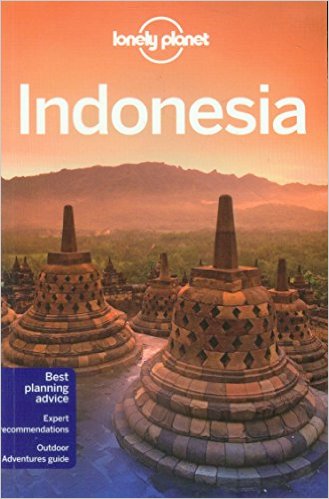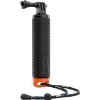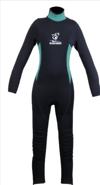Indonesia is a country of over 18,000 islands of varying sizes, but don’t expect to visit them all. If you visited a new island every day it would take you about 50 years to go to them all! Indonesia’s capital, Jakarta, is one of the biggest and culturally diverse cities in the world. It’s situated on Java island which holds more than half the population, so expect traffic jams!
While Java is where most people start their travels it is the other islands that hold all the charm. Bali is by far the most well known and offers idyllic scenery, yoga, temples and great surfing. Flores and the Gili islands also offer gorgeous beaches, surfing and some amazing snorkeling in crystal clear water. Neighboring island Lombok is dominated by the climbable Gunung Rinjani volcano, while to the north Sulawesi offers some of the best diving spots in the world! On land Indonesia is home to dense jungles, volcanoes, remote tribes and thousands of rare species including the Komodo dragon and the endangered Orangutan. Sumatra is the largest of Indonesia’s island and holds lake Toba, the largest volcanic lake in the world (which also has a smaller island within the lake).
Kalimantan is the Indonesian half of Borneo and home to ancient tribes, some still living isolated in the forests and only accessible through jungle treks. Meet them and see how ancient wisdom still exists today. Papua is Indonesia’s easternmost island, covered with unexplored jungle and snowcapped mountains, and difficult to travel in due to the recent conflict that split the worlds largest tropical island into two countries. With the exception of the beautiful beaches on and around Bali, most of Indonesia is untouched by tourism and is the place for true adventure!
Indonesia has a tropical climate which varies seasonally and regionally, though temperatures stay the same year-round and average about 30°C in the coastal plains, 27°C in the mountains and a couple degrees colder in the higher mountain areas. It is also a wet country which receives significant and consistent precipitation, including thunderstorms. Despite year-round rain, both natives and tourists recommend visiting between May and September for an optimal experience, while January and February are the wettest months - though the opposite is true for northern Sumatra.
Wet Season
October — April
Average temperature
88–72 °F
31–22 °C
Average number of rainy days 14
Dry Season
May — September
Average temperature
88–72 °F
31–22 °C
Average number of rainy days 5
Average temperature
Average number of rainy days
The following links are affiliate links to Amazon.com or other local Amazon web stores - it depends on your location. The listed prices of all items are the US Amazon store prices at the time of publishing. If you are visiting us from outside the USA and there is an analogous item in your local Amazon web store, you'll be redirected there automatically. We do our best to keep all prices and descriptions up to date, but if you find any errors or inaccuracies, don't hesitate to contact us using our feedback page!
Recommended Travel Guides4
City walking10 items
Indonesia is a country of islands, and it possesses over 18,000! But even if you would like to spend some time hopping from one gorgeous isle to another, it would take your whole life to get to all of them. Instead, most travelers choose to visit the more famous islands, such as Java, Kalimantan, Sumatra, Sulawesi and Papua. All of these islands have beautiful cities you won’t want to miss. Of course, you also shouldn’t miss the capital, Jakarta. It is a huge, vibrant and rapidly developing city with lots of different districts.
It’s quite likely that when you plan your big Indonesian journey, you’ll end up visiting not only Jakarta, but also Yogyakarta in Java, Ubud in Bali, Medan in Sumatra, Manado in Sulawesi Jayapura in Papua, and a few cities in Kalimantan. Some of these destinations are amazing to explore while others are just gateways to more intriguing places and activities.
Regardless, you will probably need some of the following items to feel more comfortable when strolling the streets of these metropolitan areas.
-
Good daypack
-
Sunglasses
-
Face sunblock
-
Body sunblock
-
Hats
-
Camera (portraits and city views)
-
Portable battery charger (for your phone and camera)
-
Facial cleansing wipes
-
Hand wipes
-
Rain poncho and travel umbrella
Rain ponchos and umbrellas are must-haves in Malaysia! If you come from a place where it rains sparsely, you’ll be amazed at how heavy rain can be in Malaysia. Honestly, it’s usually easier to stop by a cafe or store and wait until it’s over. However, for the times you don’t have that opportunity, it’s imperative to keep a light rain poncho and a small umbrella in your backpack.
Beaching10 items
Balangan and Pandawa beaches in Bali, Air Manis beach in Sumatra, Bira beach and Tomini Bay in Sulawesi, Pink beach in Komodo, Gili Islands beaches in Southern Lombok, Riung beach in Flores - this is, of course, just a small list of some amazing beaches in Indonesia. You can definitely find your own beach perfect for relaxation, or perhaps for swimming among the waves! It doesn’t matter exactly where you’re going; if you’re beach-bound in general, you had better be prepared for the cruel tropical sun and protect your skin.
-
Body sunblock
-
Face sunblock
-
Sun oil
-
After sun care
-
Moisturizing spray
-
Sunglasses
-
Hats
-
Portable shade for the beach
This thing is extremely important, as you cannot always find natural shade on islands.
-
Hand wipes
-
UV protection shirts
 O'Neill UV Sun Protection Men's Basic Skins Long Sleeve Crew Rashguard$24.14
O'Neill UV Sun Protection Men's Basic Skins Long Sleeve Crew Rashguard$24.14 O'Neill UV Sun Protection Men's Basic Skins Tee Rashguard$24.95
O'Neill UV Sun Protection Men's Basic Skins Tee Rashguard$24.95 O'Neill UV Sun Protection Women's Basic Skins Long-Sleeve Rashguard Top$17.96
O'Neill UV Sun Protection Women's Basic Skins Long-Sleeve Rashguard Top$17.96 O'Neill UV Sun Protection Women's Basic Skins Short-Sleeve Crew Rashguard Top$17.99
O'Neill UV Sun Protection Women's Basic Skins Short-Sleeve Crew Rashguard Top$17.99 Speedo Kid's UV Long Sleeve Sun Shirt$18.95
Speedo Kid's UV Long Sleeve Sun Shirt$18.95
Snorkeling2 items
Indonesia is blessed with one of the richest marine ecosystems on Earth. If you are snorkeling or diving, there are plenty of spots to fully enjoy your underwater adventure by seeing so many incredibly beautiful creatures that you could never see anywhere else. Almost every island or system of islands (e.g. Sulawesi) will give you this unique chance!
Before going to snorkel in Sulawesi, Komodo, Banyak, Derawan (famous for the jellyfish lake) and Papua islands, you’ll need some equipment. Of course, you can rent some items right at the beach or at the diving centre, but the quality and condition probably won’t be great. It’s always better to have your own.
-
Snorkeling set: fins, mask, tube
-
UV protection shirts
 O'Neill UV Sun Protection Men's Basic Skins Long Sleeve Crew Rashguard$24.14
O'Neill UV Sun Protection Men's Basic Skins Long Sleeve Crew Rashguard$24.14 O'Neill UV Sun Protection Men's Basic Skins Tee Rashguard$24.95
O'Neill UV Sun Protection Men's Basic Skins Tee Rashguard$24.95 O'Neill UV Sun Protection Women's Basic Skins Long-Sleeve Rashguard Top$17.96
O'Neill UV Sun Protection Women's Basic Skins Long-Sleeve Rashguard Top$17.96 O'Neill UV Sun Protection Women's Basic Skins Short-Sleeve Crew Rashguard Top$17.99
O'Neill UV Sun Protection Women's Basic Skins Short-Sleeve Crew Rashguard Top$17.99 Speedo Kid's UV Long Sleeve Sun Shirt$18.95
Speedo Kid's UV Long Sleeve Sun Shirt$18.95 -
GoPro camera
-
GoPro LCD display
-
Hand buoy
-
Anti fog pads
Scuba diving7 item
Indonesia is blessed with one of the richest marine ecosystems on Earth. If you are snorkeling or diving, there are plenty of spots to fully enjoy your underwater adventure by seeing so many incredibly beautiful creatures that you could never see anywhere else. Almost every island or system of islands (e.g. Sulawesi) will give you this unique chance!
Before going to dive in Sulawesi, Komodo, Banyak, Derawan (famous for the jellyfish lake) and Papua islands, you’ll need some equipment. Of course, you can rent some items right at the beach or at the diving centre, but the quality and condition probably won’t be great. It’s always better to have your own.
-
Diving wetsuit
-
Snorkeling set: fins, mask, tube
-
GoPro camera
-
GoPro LCD display
-
Red filter (essential for deep blue water)
-
Hand buoy
-
Anti fog pads
Mount hiking18 items
Indonesia boasts an impressive total of 147 active volcanoes! It’s an amazing adventure and a great challenge to climb these mounts. As a fair reward you’ll get a fantastically scenic view (e.g. Mt. Bromo, Mt. Rinjani) of sunrise or sunset, meet some local people who work truly hard to earn a meager living (e.g. Ijen complex) and enjoy some magical wildlife in the lush forest (e.g. Mt. Kerinci, the highest volcano in Indonesia). Not all of these treks involve well-developed trails, and at some spots you cannot even breath properly (e.g. Ijen complex) due to acid evaporation, so you’ll need to make careful and thorough preparations in order to have a great time during these challenging treks.
-
Good daypack
-
Jungle boots
-
Trekking poles
-
Trekking socks
-
Jungle rain poncho
-
Torch and headlamp
-
Extra torch batteries
-
Warm trekking gloves
-
Softshell jacket
-
Fleece beanie
-
Anti leech socks (if rain season)
-
Altitude sickness pills
-
Face sunblock
-
Antiseptic wipes
-
Waterproof bandage
-
Lighter
-
Knife
-
Good binocular
Surfing10 items
Indonesia is a veritable surfer’s paradise, where myriad surfing spots of various complexities await. If you simply want to try surfing, then you should go to Bali. There, you can find many surf schools which teach in various languages. If you’re a bit more than a beginner, then try some of the amazing surfing spots in Mentawai, West and East Java, Sumatra and the Lombok Islands. Don’t forget the crucial step of checking the season and wave condition before picking your destination. And, of course, be prepared for the beating sun!
-
UV protection shirts
 O'Neill UV Sun Protection Men's Basic Skins Long Sleeve Crew Rashguard$24.14
O'Neill UV Sun Protection Men's Basic Skins Long Sleeve Crew Rashguard$24.14 O'Neill UV Sun Protection Men's Basic Skins Tee Rashguard$24.95
O'Neill UV Sun Protection Men's Basic Skins Tee Rashguard$24.95 O'Neill UV Sun Protection Women's Basic Skins Long-Sleeve Rashguard Top$17.96
O'Neill UV Sun Protection Women's Basic Skins Long-Sleeve Rashguard Top$17.96 O'Neill UV Sun Protection Women's Basic Skins Short-Sleeve Crew Rashguard Top$17.99
O'Neill UV Sun Protection Women's Basic Skins Short-Sleeve Crew Rashguard Top$17.99 -
Face sunblock
-
Body sunblock
-
Waterproof bandage
-
Antiseptic wipes (if you have some small wounds, scratches)
-
Universal injury relief ointment
-
After sun care
-
Quadcopter with camera
-
GoPro camera
-
Quadcopter for GoPro
Komodo dragon searching11 items
Indonesia is home to the largest living species of lizard, the famed Komodo dragon. You can see these rare animals in their natural habitat on the following islands: Komodo, Rinca, Flores, Gili Motang, and Padar. Most people visit the Komodo National Park on Komodo Island and do a one- or two-day trek there. But before you depart, there are a few things you must know in advance, as it is possible to be attacked by the dragon.
Without further ado, here are the things you should do and be aware of while seeing the Komodo dragons:
1. Listen to your guide or park ranger and stay close to him. This is especially true during the daily feeding time, as Komodo dragons may approach the guest area and are not afraid to jump to get food.
2. Stay aware and try to steer clear of any wildlife - including snakes, which can also be problematic. This includes looking up occasionally, as younger Komodos (while not quite as dangerous as adults) sometimes live in trees. You might be given a large, Y-shaped pole by your guide or a park ranger; this is mainly used as a walking stick and to keep your path clear, but as a last resort it can be used to defend you against aggressive wildlife.
3. Steer clear of the Komodo dragons. While your goal will be to glance at them from afar, they become a real threat when you get close to them. They can run faster than humans and even swim in strong waters, so if you do make one angry, escaping will be difficult.
4. Komodo dragons bite. Humans can lose a lot of blood from the bites of Komodos, and recent zoological theories suggest that the animals might even be venomous. Thus, while you should be aware of your surroundings at all times, extra precaution is required when Komodos are in sight.
5. Women should avoid visiting islands with Komodo dragons during their menstruation. Komodos can detect blood incredibly well, so it can put you in extra danger.
-
Good daypack
-
Face sunblock
-
Body sunblock
-
Hats
-
Light hiking boots
-
Sunglasses
-
Camera and zoom
Since it’s dangerous to approach the dragons for a close-up shot, I would recommend having a good zoom for your camera. However, choosing a good zoom is not a simple task. If photography (especially of wildlife) is or is going to be one of your passions, then you need to invest in a good camera with a good zoom. After searching and investigating a lot about what camera and lens are the best for shooting wildlife on a safari, I finally bought Canon Zoom EF 100-400 mm f/4.5-5.6L IS II, as it allows you not only shoot nice landscapes, but it has a good shooting quality at a distance. Most of the animals will not be posing in front of you; they are shy and will most likely stay far away. Plus, in countries where you need your zoom the most, the weather and light conditions are very tricky. Direct sun rays (savannah) or high humidity (rainforest) are not the easiest issues to handle when shooting. That’s why you need a zoom with a good aperture. Another Canon option I personally considered was zoom EF 70-200 mm f/2.8L IS II USM, as it has better aperture than 100-400, but the zoom is weaker for animals that are too far away. So in short, it’s a very personal question what camera and zoom you should bring on a safari or expedition. I would say if shooting animals is not your main goal, it’s better invest more money in good binoculars and enjoy them in real life.
-
Monopod (might be useful to photoshoot dragons on a distance)
-
Quadcopter with camera
-
GoPro camera
-
Quadcopter for GoPro
Jungle trekking22 items
Indonesia, like Malaysia, is a rainforest paradise. There are plenty of national parks, many of which are World Heritage sites, where you can do both short (half-day) trips and long (more than a week) treks. One of the prime reasons to go on a jungle trek is to see wildlife: hornbill birds, proboscis monkeys, orangutans, lots of diverse insects, spiders, reptiles, and a plethora of other amazing creatures. Lots of parks are located on the Kalimantan and Sumatra islands, so travel logistics are often difficult due to the remote location and undeveloped territories.
You should keep in mind that the rainforest is a huge ecosystem and every creature, even if it’s very tiny, can protect itself well! For example, leeches are not something you’d want to mess with. While getting leeches is not the absolute worst experience you could have, they’re still highly unpleasant. Also, your typical hiking boots are not an option in the Indonesian rainforest, due its very high humidity. Since normal hiking boots are made of leather, organisms could find them attractive and move in there. If this happens, then after only a few days of trekking, you’ll basically need to throw them away.
When I was preparing for my first jungle experience, I searched far and wide to find the type of boots which would be best for me. Then, I recalled that the US army had created jungle boots specifically for its soldiers when there was a war in Vietnam. I googled this and ended up buying a pair of these boots. After I did few treks in them, I realized that I had made a very smart choice. The boots are made with an artificial fabric and materials which get dry much quicker than normal hiking boots (which is ideal, considering humidity). They also have very good ankle support and they are tall, so you can wear your leech socks and you won’t be afraid of getting bitten.
Other items mentioned below are also must-haves for jungle trekking. Garbage bags, for example, could be very useful when you have a boat ride somewhere in the depths of the jungle. If you put all your bags in separate garbage bags and seal them with a sealing tape, it keeps them from getting wet if it’s raining. I usually use 2-3 garbage bags for each of my bags - a solution which costs much less than a raincover for your bags. Additionally, considering how heavy the rain in the Malaysian jungles can be, a raincover won’t really help you at all!
-
Good daypack
-
Waterproof bag
-
Anti leech socks
-
Jungle boots
-
Long hiking pants
-
Jungle rain poncho
-
Waterproof bags for camera and documents
-
Good binocular
-
Whistle
-
Torch and headlamp
-
Extra torch batteries
-
Lighter
-
Jungle knife
-
Sealing tape
-
Plastic bags
-
Rope
-
Adjustment to vertical peeing for girls
-
GoPro camera
-
Insect head hat
-
High DEET insect repellent
-
Antiseptic wipes
-
Waterproof bandage
Meeting locals3 items
Indonesia is a country of about 300 distinct native ethnic groups. Some of them are truly astonishing and definitely worth visiting. Among the more famous ones are the Batak people in North-Central Sumatra (Batak people are famous for their long houses and very curious relationship with death), the Dayak people in Kalimantan (to be a man in their community, a boy should bring the head of an enemy), the Korowai people (famous for their houses built on very tall trees) and the Mentawai people (famous for their amazing body art).
Of course, it takes a lot of time to visit even one village. For instance, to visit the Korowai people, you’ll need to fly to Papua province and from there, you have to spend about 2 days on the water. No comfortable ferries are there, of course, and you’ll have to bring all of your things plus food and water (which will be on separate boats). That being said, the reward for this experience is undoubtedly amazing! You’ll see elders who continue living in their traditional style, while young people have already left the houses and moved into the village. So, it’s really a unique experience. Imagine taking pictures and sitting with them; it’s the opportunity of a lifetime!
My friends have been to Namibia and visited the Himba people. Besides some food and small presents they brought along, they also brought a typical Russian sweet condensed milk. They had a very lovely evening sitting together, chatting and eating bread with this sweet milk! Other friends of mine visited the Korowai people, and besides vodka, they had some summer sausage to share with the people. It was an amazing experience to watch these people trying new things.
Since some of these people live in very remote areas covered with lush forests, it might be wise to have some items from the “jungle trekking” packing kit or other kits, as the people might also offer you some activities like hunting, fishing and others. Here is this list you’ll find some items which might be useful particularly when communicating with the people. It’s usually a very polite to bring something to the table when visiting a friend! Alcohol and cigarettes would be a good option for the chief, but also some small items like sweets or colored pencils will help you get a better communication. And don't forget about proper clothing (long sleeve shirts are better than tanks) to show some respect to the people.
-
Good camera (portraits, object, landscapes)
-
"Polaroid"-type camera
Polaroid-type camera makes immediate pictures to present them as well. This camera is small, relatively cheap and allows you to produce photos immediately. One of the greatest options is by Fuji, as they recently issued a very good Instax model for shooting and getting images immediately.
-
Small presents
Caving12 items
Indonesia has a ton of caves to explore. One of the most famous and a relatively easy accessible cave is Goa Jomblang. Located near Yogyakarta, it is full of true wonders like an underground river, interesting stone formations and beautiful interior landscapes.
-
Rubber boots
The cave route is pretty slippery, so you won’t want to wear your running or hiking shoes or trekking sandals. None of these will help you. Instead, a pair of rubber slippers is the best option to crawl through the caves.
-
Good socks
-
Waterproof bag
-
Grip gloves
You’ll need them. Some parts of the route are equipped with a rope, and since it’s very humid and dirty in the cave, your hands will be wet and grimy. It’s always safer to have grip gloves when sliding on a rope.
-
Torch and headlamp
-
Extra torch batteries
-
Lighter
-
Knife
-
Sealing tape
-
GoPro camera
-
Adjustment to vertical peeing for girls
-
Swimsuit
Vaccination7 items
Make sure you are up-to-date on routine vaccines before every trip. Don't forget to consult a doctor about necessary vaccination a few months in advance. Generally, these vaccines include the measles-mumps-rubella (MMR) vaccine, diphtheria-tetanus-pertussis vaccine, varicella (chickenpox) vaccine, polio vaccine, and your yearly flu shot. The following vaccination recommendations are taken from the Centers for Disease Control and Prevention (CDC) webpage.
Hepatitis A
Typhoid
Hepatitis B
Japanese Encephalitis
Malaria
Rabies
Yellow fever
First Aid Kit6 items
Of course, Indonesia is a country where you can have some qualified help. However, in some remote areas it will take a while to get proper treatment. Sometimes, not you but some of your traveling buddies might need help. Make sure you have something in advance against the following symptoms:
Wounds, traumas, cuts
Gastro problems like poisoning or heartburn
Allergic reactions on sun burn, bites of insects, unusual food
Fever and cold
Motion sickness
Strong painkillers


































































































Like this packing list
Like VacayKit